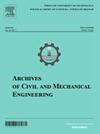Exploring the synergistic mechanisms of mechanical, microstructural morphology, and corrosion characteristics in inconel 718-AISI 430 dissimilar weldment joints using ERNiCrMo-4 and ER2209 fillers: a comparative performance analysis
Abstract
The comparative study is made on dissimilar weldments of Inconel 718 and ferritic stainless steel 430 joined by pulsed current tungsten inert gas welding process using ERNiCrMo-4 and ER2209 fillers. The base metals were joined with multiple welds passes by keeping pulse frequency (4 Hz) constant. The samples were examined for internal defects using X-ray radiography along with visual inspection. To understand the weldability of two different fillers, the mechanical properties were assessed by conducting a tension test as well as the hardness measurement. The macro/microstructures were revealed at various zones using an optical microscope with different magnifications. Further, for measuring the corrosion rate at fusion zone, the weld surface area of 0.1257 cm2 was submerged in a 3.5% NaCl solution. The weld strength of 542 MPa was observed for ERNiCrMo-4 weldment whereas 469 MPa was observed for ER2209 filler weldment. Higher yield strength to weld strength was observed in ERNiCrMo-4 filler weldment than in the ER2209 filler weldment. ERNiCrMo-4 filler weld exhibited better hardness (198 HV) at the weld zone than the ER2209 filler weld (185 HV). The presence of a fine-grained structure at the interface of ferritic stainless steel 430 provides evidence of efficient blending and solidification in ERNiCrMo-4 filler weld. Whereas the elongated grains and secondary phases could potentially reduce the strength of ferritic stainless steel 430 in ER2209 filler weld. The corrosion resistance of ER2209 weldment (1.117 mm/year) is higher than the ERNiCrMo-4 weldment (1.353 mm/year) because of the presence of fine grain structures along with higher dense filler alloy elements.

 求助内容:
求助内容: 应助结果提醒方式:
应助结果提醒方式:


